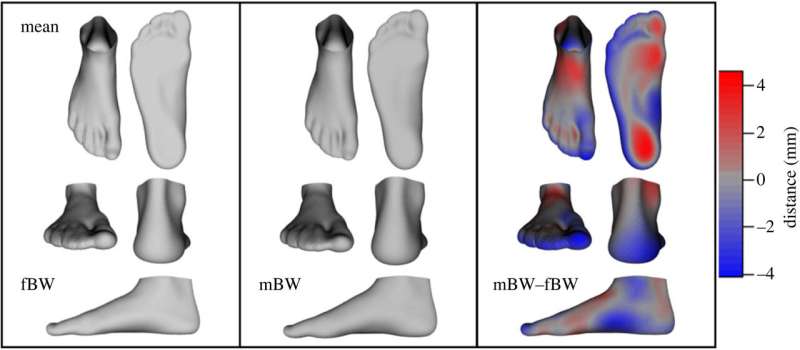This article has been reviewed according to Science X's editorial process and policies. Editors have highlighted the following attributes while ensuring the content's credibility:
fact-checked
peer-reviewed publication
trusted source
proofread
Overcoming a 'stiff' reputation: Research highlights foot's variability and movement capability

A research collaboration between Griffith University and The University of Queensland is reshaping our understanding of human biomechanics, specifically through the interplay of foot form and function.
Griffith's Dr. Robert Schuster and Associate Professor Luke Kelly, alongside Professor Andrew Cresswell from UQ's School of Human Movement and Nutrition Sciences went beyond historical examination of foot components in isolation, highlighting the foot's complex morphology, variability, and movement capability.
Dr. Schuster said the long-held idea that the foot is a stiff structure is limiting in its scope.
"As we walk and run, we use our foot to push off the ground, and there's been this assumption that to do that effectively without wasting a lot of energy, the foot is very rigid, and doesn't move a lot," he said.
"But the foot has 33 joints, it's a very complex structure."
Using the data of 100 healthy participants aged 18–40, collected using novel measurement and analysis techniques that defy 'standard' foot measures used in many practices, the team not only confirmed how different our feet are, but also developed a shape-function model (SFM).
This SFM evolved from statistics identifying patterns in the combined shape and function data without making any prior assumptions about how they might relate to each other.
The model proved remarkably accurate in predicting how the joints of a novel foot move and the forces they experience, based solely on its shape.
Dr. Schuster said by taking a more holistic approach and dramatically expanding typical sample size for the study, researchers were able to better understand shape variability and the intricate dance of joint mechanics in motion.
"Whether it was a high arch, stiff foot, low arch, or more compliant foot, we did see some relationship between type and function, but those relationships only account for a very small percentage of what's going on in the foot," he said.
"What people often do is look for clues in the way something looks, a biological structure like our foot or hand, to understand what it's good at doing or what injuries you might be prone to.
"For instance, when you think of a marathon athlete, the typical body shape that comes to mind is a short, very light build, with very thin limbs.
"Whereas if you think of a sprinter, you'd imagine a more muscular type, and that's the idea behind the form and function relationship.
"When you apply this to the foot, it would suggest a flat foot does one thing and a foot with a high arch does another, but the foot is probably one of the most variable structures in our body."
The study, involving 3D scanning and walking, and running trials, determined the foot's longitudinal and transverse arches, relative proportions and toe shape are connected to changes in ankle and foot joint mechanics, but do not solely predict movement potential due to the multiple degrees of freedom in the foot.
"What this study shows is our feet can look very different, but they can still perform the exact same function because how they perform that function differs," Dr. Schuster said.
"For example, people might say if your foot is flat then you're in trouble or limited as to what it can do, but we have high performing athletes with flat feet.
"Just because you have a certain foot shape doesn't mean your foot has to function in a certain way, because it can compensate at different joints.
"Having a flat foot doesn't mean you're going to develop plantar fasciitis necessarily, because you have so many muscles and joints that can make up for that structure."
Global sports brand ASICS supported the study by providing complimentary footwear to all 100 participants.
Dr. Schuster said such findings and the effective SFM could be harnessed by sportswear brands to deliver a more beneficial, bespoke fitting service.
"When you walk into a shop, most people prioritize fit because you want to be comfortable in the shoe, but there's potential to meet and improve both fit and function," he said.
"Somebody running a marathon might be recommended super thick foam under the shoes, but that might not be good for everybody.
"Just as our feet are different, we might need shoes with different density or stiffness in the foam, for the same function."
Beyond footwear design, the research brings new value to orthopedics, sports science, biomechanics and evolutionary biology.
The paper," Human foot form and function: Variable and versatile, yet sufficiently related to predict function from form," was recently published in the Proceedings of the Royal Society B: Biological Sciences
More information: Robert W. Schuster et al, Human foot form and function: variable and versatile, yet sufficiently related to predict function from form, Proceedings of the Royal Society B: Biological Sciences (2024). DOI: 10.1098/rspb.2023.2543





















